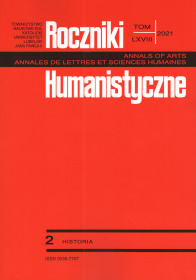Sztuka w służbie imperium i narodu: casus bizantyjskich fresków w kaplicy Św. Trójcy na Zamku Lubelskim w świetle poglądów rosyjskich historyków (XIX –początek XX wieku)
Art in the Service of Empire and Nation: The Case of Byzantine Frescoes of The Holy Trinity Chapel in Lublin Castle Through the Lens of Russian Historians (19th ‒ Early 20th Century)
Author(s): Matteo PiccinSubject(s): History, Modern Age, Recent History (1900 till today), 19th Century, Pre-WW I & WW I (1900 -1919)
Published by: Towarzystwo Naukowe KUL & Katolicki Uniwersytet Lubelski Jana Pawła II
Keywords: Holy Trinity Chapel in Lublin Castle; Kingdom of Poland; Russian Empire; russian nationalism; antiquities
Summary/Abstract: The purpose of this article is to reflect on Russian nationalism ‒ its significance and territorial range, real and imagined ‒ in the Kingdom of Poland at the turn of the 19th and 20th centuries. As a case study, the author chose the renowned Byzantine frescoes from the early 15th century that cover the inner walls of the chapel of the Holy Trinity in the Lublin Castle. The author considers whether, due to the presence of Ruthenian frescoes, whose uncovering dates back to early 20th century, Russian nationalists understood Lublin as a “Russian” (Ruthenian) city, which would then need to undergo Russification (as had occurred in the neighbouring Chełm region for at least the previous 30 years). Where then was the border of Russian nationalism? Given Lublin’s location on the border with the Chełm land, the discovery of the paintings could have caused a radical reassessment in the perception of the city as Polish.Well-known Polish intellectuals, as well as Russian archaeologists historians and zealous seekers of antiquities took part in the debate about the origin of the frescoes and their attribution. The First World War interrupted all conservation projects, and with them any further attempt at unearthing Lublin’s “Russiannes”.
Journal: Roczniki Humanistyczne
- Issue Year: 69/2021
- Issue No: 2
- Page Range: 105-142
- Page Count: 38
- Language: Polish

